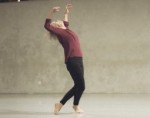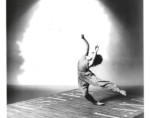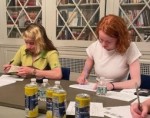
De Keersmaeker’s Golden Jubilee
by Charly Santagado
Self-described during the post-show Q&A as a “golden jubilee of her relationship with dance,” Anne Teresa de Keersmaeker’s solo dance, The Goldberg Variations, BWV 988, brings body and piano into a profound dialogue in which silence holds its own cadence.
At the start, the piano keys gleam like an invitation, and de Keersmaeker seems to slide her bare feet to the rhythm of an unheard music in the dim light. At times she appears to be on the verge of speaking, though perhaps she already is with her body. Soon, pianist Pavel Kolesnikov (tank topped and barefoot) begins to play softly. At first, de Keersmaeker’s small jumps, precise gestures, vacillating facings, gentle inversions, flat-footed chaine turns, and pacing don’t show an obvious connection to the music, but as the dance progresses, her movements modulate their distance from the score. Like the music, de Keersmaeker’s choreography is structural without being systematic, and she often dances through the pauses between musical variations. At other times, she centers herself amidst the swirl, holding in stillness and framing her face with a triangular handshape. Kolesnikov’s playing is so seamless that it frequently falls from the foreground, but when de Keersmaekeer pauses or slows, the audience is reminded just how much Kolesnikov is also in motion.
According to de Keersmaeker and Kolesnikov, The Goldberg Variations embody a powerful spiritual journey despite being Bach’s largest secular work. Through the score, Bach attempts to marry the past with the present and the future by blending the splendor of polyphony with new, lighter forms of music making. De Keersmaeker takes a similarly blended approach to her choreography, quoting her earlier works and adopting an unhurried tone. Moments that seem a hybrid between the practical and the choreographic constitute a kind of poetic more than a technical analysis of Bach’s seminal work.
Because of the dance field’s systemic ageism, de Keersmaeker’s 63-year-old dancing body almost cannot help but comment on its age. The silvers and golds that compose the visual space lend plenty of possible interpretations on this front. The gold of youth. The silver of age. The golden years. This subtle commentary on maturity and youth is confirmed during the Q&A when the artists tell us that the work loosely traces the story of Goldberg himself who was a very young harpsichord player tasked with entertaining an elderly man during his sleepless nights.
In the latter half of the piece, Kolesnikov returns in slacks and a button down, and de Keersmaeker dons a tan track suit of sorts. Her movement is not overly polished, which lends the feeling of watching something happening in a dance studio rather than on a concert stage. She torques from her shoulders, blows invisible flower petals from her hands, swings her legs in parallel fouettes, takes her shoes off and puts them on again. The minutiae of her many facings somehow seem unambiguous, almost as though they are numbered. She occasionally counts (on her fingers and aloud) the dance’s sections, and these breaks out of “dancer” and into personhood reminds us that “oh yeah, she’s dancing.” Her quirkiness cumulatively escalates into its own language, one which never becomes quite legible through the translucent window she offers us into her world.
Anne Teresa de Keersmaeker: The Goldberg Variations, BWV 988, NYU Skirball, February 22–24
By Charly Santagado
March 15, 2024










